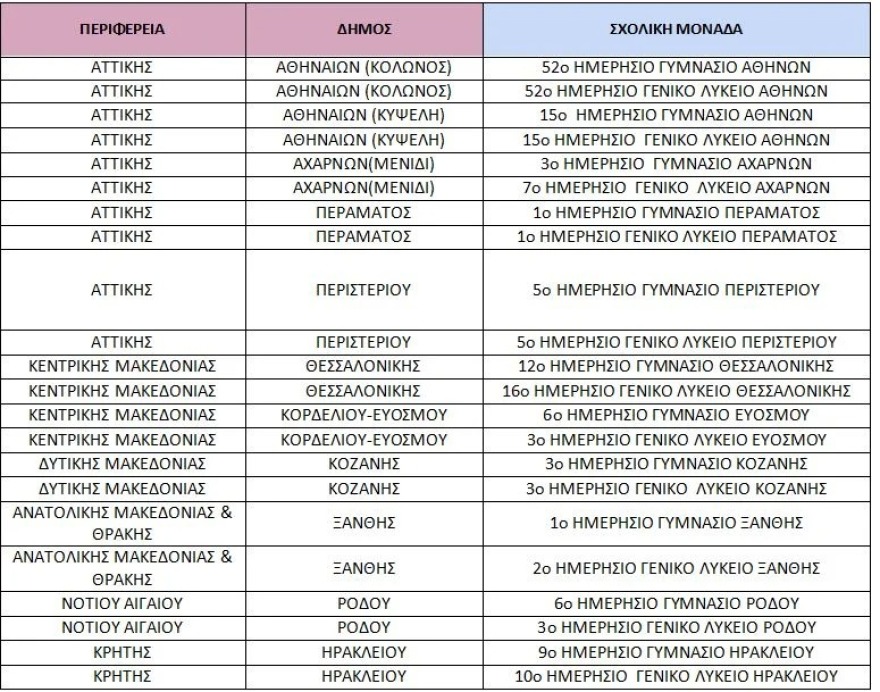Onassis Schools:In which districts they will operate,what their objective is,how students will be admitted

The signing of the Contract between the Greek State and the Onassis Foundation paves the way for the establishment of the Public Onassis Schools (DIM.O.S) network. These are 22 schools (11 high schools and 11 general high schools) that will operate in areas of the country facing social and economic challenges and will provide thousands of students with the skills, knowledge, and environment they need to develop their skills.
The DHS will operate under the supervision of the Ministry of Education, Religious Affairs, and Sports, in close cooperation with the Onassis Foundation, which will undertake their building upgrades and cover part of their operating costs. The timetable will be similar to that of the Model Schools and will include additional innovations in terms of how they will be linked to universities and research centres, while the operation of the Educational Groups and Ensembles will also be accessible to pupils of neighbouring public schools.
The Public Onassis Schools come to multiply educational opportunities, strengthen local communities, increase the osmosis between public schools, universities, and institutions, and set the tone for the overall upgrade in education that is the goal of the Ministry of Education, Religious Affairs and Sports.
1. What are Public Onassis Schools?
It is a network of existing public schools, which with funding from the Onassis Foundation will be transformed into Public Onassis Schools, under the supervision of the Ministry of Education, Religious Affairs and Sports. These are 22 schools (11 high schools and 11 lyceums) throughout the country. At least the first 6 schools (3 Lyceums, and 3 Gymnasiums) will be operational in September 2025, which will be announced by the end of January 2025.
Students who will be attending the second and third grades of the secondary school and high school at the start of operation will remain and complete their studies in these schools. The total number of students in the DHS will reach 6,000 per year and a total of more than 22,000 over a twelve-year horizon.
2. In which regions will the DHSs operate ;
Of the total of 22 schools, 10 (Gymnasiums – Lyceums) will operate in the Region of Attica and 12 in the rest of Greece. In Attica, the DIMS will be established in Kolonos, Kipseli, Menidi, Perama,and Peristeri. In Thessaloniki, the areas chosen are Xerokrini and Evosmos. In the region, DIM.O.S. will welcome Kozani, Xanthi, Rhodes, and Heraklion.
The main selection criterion was to support regions facing social and economic challenges. It was also a prerequisite that there were no other model or experimental schools in the vicinity, while the geographical proximity of the selected high schools played a role, in order to facilitate cooperation between them and their collaboration with higher educational institutions and research centres.
The final decision on the regions was taken after close cooperation between the Ministry of Education, Religious Affairs and Sports and the Onassis Foundation.
3. How will the Onassis Public Schools be managed?
The Network of the Public OSS will be managed by a nine-member Committee, five members of which will be appointed by the Ministry of Education, Religious Affairs and Sports by decision of the competent Minister. The remaining four members are nominated by the Onassis Foundation.
The responsibility for the day-to-day operation of the DHS will be held by a) the Director, b) the Deputy Director, and c) the Teachers’ Association. The school units included in the Network are administratively under the administrative authority of the relevant Directorate of Secondary Education.

4. What is the aim of the DHS?
The formation of integrated citizens. The provision of high-quality public free education of high quality aimed at the all-round, harmonious, and balanced development and cultivation of students.
The implementation of innovative educational programs using experiential teaching methods and other innovative teaching practices and actions. The promotion of scientific research in education, the promotion of students’ training in digital technology and artificial intelligence and the promotion of multilingualism.
5. How will the Onassis Public Schools operate?
Attendance will be completely free of charge. The Public HSEs will follow the curriculum of the Model Schools, emphasizing Humanities, Science and Social Sciences, Fine Arts, Digital Literacy, and Emotional and Social Intelligence. To achieve the objectives, in addition to the timetable applicable to the Standard Schools, there will be Groups and Ensembles with additional subjects in Science, Humanities, Languages, Art, Culture and Sport. In the Groups, innovative activities, supportive teaching, and preparation for the Panhellenic examinations will take place.
The participation of pupils in the Clubs and the Groups will be compulsory for at least 10 hours of education per week throughout the school year.
6. Will the DHS interact with other public schools in the district?
The goal is for osmosis that will help overall improve public education. Students from other public schools in the same geographic area may participate in Clubs and Ensembles upon application and approval by the Director of Public Schools.
7. How will pupils be admitted to the DHM.O.S. and how will the teaching staff be selected?
The admission of students to the Upper Secondary School and the Upper Secondary School will be done by a similar procedure as for the Standard Schools with participation in written examinations (tests) of knowledge and skills.
The teaching staff of the DHS will also be selected by a similar procedure as for the teaching staff of the Standard Schools.
8. What are the obligations of the Onassis Foundation under the contract?
The Onassis Foundation, through a donation totaling 160 million euros for 12 school years, will cover the equipment and building upgrades of the existing building infrastructure of the 22 school units. It will provide up to €1,000,000 per school unit to upgrade and improve the infrastructure and up to €500,000 per school unit per school year to support actions and cover costs. In addition, the Onassis Foundation will allocate the amount of 6,000,000 euros to cover extraordinary costs arising from the operation of the Onassis Schools network.
The Onassis Foundation will cover the additional remuneration of the teachers and administrative staff of the Municipal Schools for their additional work beyond their working hours, as well as the costs for the operation of the Groups and Ensembles. The Onassis Foundation will cover the costs for the development and training of the teaching staff through participation in educational programmes in Greece or abroad and for scholarships.
9. What are the obligations of the Greek State?
Apart from the donation from the Onassis Foundation, the financial framework of the DHS will be the same as that of the Model Schools. The salaries of the teaching and administrative staff will be covered by the Ministry of Education, Religious Affairs and Sports and the fixed operating costs of the schools will be covered by the municipalities to which they belong.
10. From when will the contract come into force?
The contract will enter into force from the date of its ratification in Parliament and its publication in the Government Gazette. It is a partnership between the Onassis Foundation and the Greek State, following the successful model of the Onassis Cardiac Surgery Centre. The “Ratification of the Donation Agreement between the Public Benefit Foundation “ALEXANDROS S. ONASIS”, the Onassis Cardiac Surgery Centre (O.K.K.), and the Greek State” was passed (27 September 2018) with a broad majority and the support of SYRIZA, ANEL, ND, Democratic Co-party, and Potami.
The school units that will be transformed into DIM.O.S.

Source: pagenews.gr
Διαβάστε όλες τις τελευταίες Ειδήσεις από την Ελλάδα και τον Κόσμο































Το σχόλιο σας